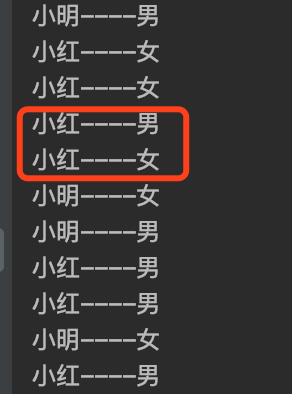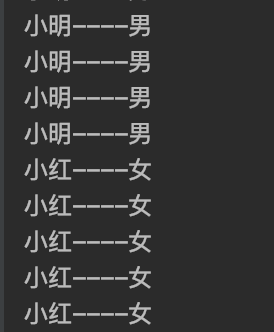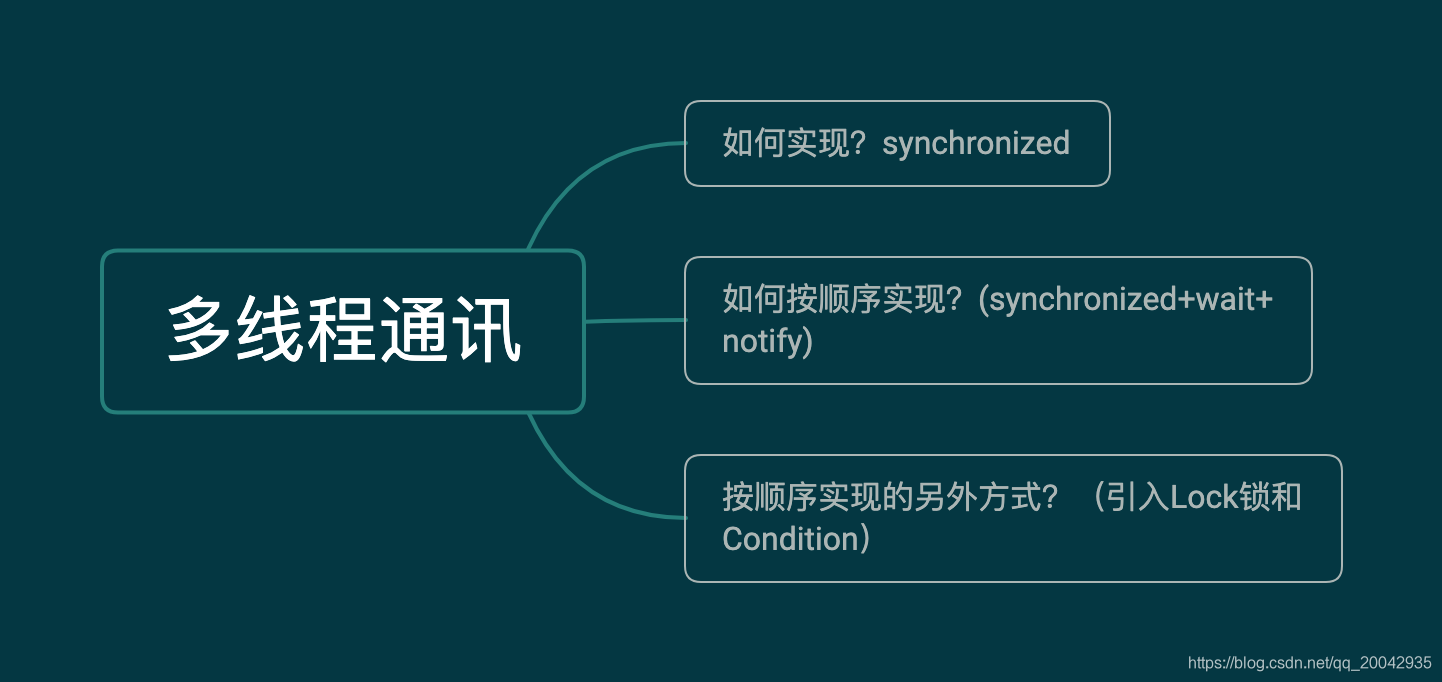代码已上传到Github,有兴趣的同学可以下载来看(https://github.com/ylw-github/Java-ThreadDemo)
1. 什么是多线程之间通讯?
多线程之间通讯,其实就是多个线程在操作同一个资源,但是操作的动作不同。
2. 多线程之间的通讯需求
需求:第一个线程写入(input)用户,另一个线程取读取(out)用户,实现读一个,写一个操作。

3. 代码实现
package com.ylw.thread;
public class ThreadMsgDemo {
//1.共享资源实体类
public static class Res {
private String userName;
private String sex;
}
//2.读取线程
public static class InThread extends Thread {
private Res res;
int count = 0;
public InThread(Res res) {
this.res = res;
}
@Override
public void run() {
super.run();
while (true) {
if (count == 0) {
res.userName = "小明";
res.sex = "男";
} else {
res.userName = "小红";
res.sex = "女";
}
count = (count + 1) % 2;
}
}
}
//3.写入线程
public static class OutThread extends Thread {
private Res res;
public OutThread(Res res) {
this.res = res;
}
@Override
public void run() {
super.run();
while (true) {
System.out.println(res.userName + "----" + res.sex);
}
}
}
public static void main(String[] args) {
Res res = new Res();
InThread inThread = new InThread(res);
OutThread outThread = new OutThread(res);
inThread.start();
outThread.start();
}
}
运行结果,会发现数据发生错乱,造成线程安全的问题:

3.1 解决线程安全问题
输入和输出线程加上同步synchronized,如下代码:
//2.读取线程
public static class InThread extends Thread {
private Res res;
int count = 0;
public InThread(Res res) {
this.res = res;
}
@Override
public void run() {
super.run();
while (true) {
synchronized (res){//同步加锁,解决多线程安全问题
if (count == 0) {
res.userName = "小明";
res.sex = "男";
} else {
res.userName = "小红";
res.sex = "女";
}
count = (count + 1) % 2;
}
}
}
}
//3.写入线程
public static class OutThread extends Thread {
private Res res;
public OutThread(Res res) {
this.res = res;
}
@Override
public void run() {
super.run();
while (true) {
synchronized (res){//同步加锁,解决多线程安全问题
System.out.println(res.userName + "----" + res.sex);
}
}
}
}
运行结果,正常:

4. wait、notify方法
1.因为涉及到对象锁,他们必须都放在synchronized中来使用。 wait、notify一定要在synchronized里面进行使用。
2.wait: 必须暂定当前正在执行的线程,并释放资源锁,让其他线程可以有机会运行
3.notify/notifyall: 唤醒因锁池中的线程,使之运行
注意:一定要在线程同步中使用,并且是同一个锁的资源。
public class WaitNotifyDemo {
//1.共享资源实体类
public static class Res {
private String userName;
private String sex;
private boolean flag = false;//线程间通讯标志
}
//2.读取线程
public static class InThread extends Thread {
private Res res;
int count = 0;
public InThread(Res res) {
this.res = res;
}
@Override
public void run() {
super.run();
while (true) {
synchronized (res){//同步加锁,解决多线程安全问题
if(res.flag){
try {
res.wait();//暂定当前正在执行的线程,并释放资源锁
} catch (InterruptedException e) {
e.printStackTrace();
}
}
if (count == 0) {
res.userName = "小明";
res.sex = "男";
} else {
res.userName = "小红";
res.sex = "女";
}
count = (count + 1) % 2;
res.flag = true;
res.notify();//唤醒因锁池中的线程,使之运行
}
}
}
}
//3.写入线程
public static class OutThread extends Thread {
private Res res;
public OutThread(Res res) {
this.res = res;
}
@Override
public void run() {
super.run();
while (true) {
synchronized (res){//同步加锁,解决多线程安全问题
if(!res.flag){
try {
res.wait();//暂定当前正在执行的线程,并释放资源锁
} catch (InterruptedException e) {
e.printStackTrace();
}
}
System.out.println(res.userName + "----" + res.sex);
res.flag = false;
res.notify();//唤醒因锁池中的线程,使之运行
}
}
}
}
public static void main(String[] args) {
Res res = new Res();
InThread inThread = new InThread(res);
OutThread outThread = new OutThread(res);
inThread.start();
outThread.start();
}
}
运行结果:

5. wait与sleep区别
-
对于sleep()方法,我们首先要知道该方法是属于Thread类中的。而wait()方法,则是属于Object类中的。
-
sleep() 方法导致了程序暂停执行指定的时间,让出cpu给其他线程,但是他的监控状态依然保持者,当指定的时间到了又会自动恢复运行状态。
-
在调用sleep()方法的过程中,线程不会释放对象锁。
-
而当调用wait()方法的时候,线程会放弃对象锁,进入等待此对象的等待锁定池,只有针对此对象调用notify()方法后本线程才进入对象锁定池准备获取对象锁进入运行状态。
6. Lock锁
在 jdk1.5 之后,并发包中新增了 Lock 接口(以及相关实现类)用来实现锁功能,Lock 接口提供了与 synchronized 关键字类似的同步功能,但需要在使用时手动获取锁和释放锁。
Lock写法:
Lock lock = new ReentrantLock();
lock.lock();
try{
//可能会出现线程安全的操作
}finally{
//一定在finally中释放锁
//也不能把获取锁在try中进行,因为有可能在获取锁的时候抛出异常
lock.ublock();
}
Lock与synchronized 关键字的区别:
-
Lock 接口可以尝试非阻塞地获取锁 当前线程尝试获取锁。如果这一时刻锁没有被其他线程获取到,则成功获取并持有锁。
-
Lock 接口能被中断地获取锁 与 synchronized 不同,获取到锁的线程能够响应中断,当获取到的锁的线程被中断时,中断异常将会被抛出,同时锁会被释放。
-
Lock 接口在指定的截止时间之前获取锁,如果截止时间到了依旧无法获取锁,则返回。
7. Condition用法
Condition 的功能类似于在传统的线程技术中的,Object.wait()和Object.notify()的功能。
完整代码,Lock与Condition的联和使用:
package com.ylw.thread;
import java.util.concurrent.locks.Condition;
import java.util.concurrent.locks.Lock;
import java.util.concurrent.locks.ReentrantLock;
public class LockConditionDemo {
//1.共享资源实体类
public static class Res {
private String userName;
private String sex;
private boolean flag = false;//线程间通讯标志
private Lock lock = new ReentrantLock();
}
//2.读取线程
public static class InThread extends Thread {
private Res res;
private Condition condition;
private int count = 0;
public InThread(Res res, Condition condition) {
this.res = res;
this.condition = condition;
}
@Override
public void run() {
super.run();
while (true) {
try {
res.lock.lock();
if(res.flag){
condition.await();
}
if (count == 0) {
res.userName = "小明";
res.sex = "男";
} else {
res.userName = "小红";
res.sex = "女";
}
count = (count + 1) % 2;
res.flag = true;
condition.signal();
} catch (Exception e) {
e.printStackTrace();
} finally {
res.lock.unlock();
}
}
}
}
//3.写入线程
public static class OutThread extends Thread {
private Res res;
private Condition condition;
public OutThread(Res res, Condition condition) {
this.res = res;
this.condition = condition;
}
@Override
public void run() {
super.run();
while (true) {
try {
res.lock.lock();
if(!res.flag){
condition.await();
}
System.out.println(res.userName + "----" + res.sex);
res.flag = false;
condition.signal();
}catch (Exception e){
e.printStackTrace();
}finally {
res.lock.unlock();
}
}
}
}
public static void main(String[] args) {
Res res = new Res();
Condition condition = res.lock.newCondition();
InThread inThread = new InThread(res,condition);
OutThread outThread = new OutThread(res,condition);
inThread.start();
outThread.start();
}
}
总结
